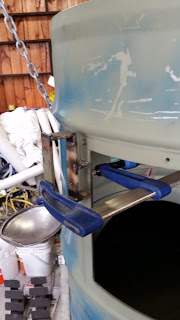Fig. #1. On Thursday I started preparing for pressure testing. I used Sikaflex to seal up the light covers and the plate that will soon hold the diving planes to the hull.
 |
| Fig. #1 29/12/2016 |
Fig. #2. The back window sealed in place. It's made from 3mm thick poly-carbonate.
 |
| Fig. #2 29/12/2016 |
Fig. #3. Breaking out the vacuum pump I bought off Ebay over a year ago.
 |
| Fig. #3 29/12/2016 |
Fig. #4. The front window sealed on. Like the rear window this is also made from 3mm thick poly-carbonate.
 |
| Fig. #4 29/12/2016 |
Fig. #5. I'm using the air inlet for the main ballast tanks as the point to where the vacuum pump will hook up to. I've also added a vacuum gauge to it as well.
 |
| Fig. #5 29/12/2016 |
Fig. #6. Sealing up the rear.
 |
| Fig. #6 29/12/2016 |
Fig. #7. I'm still not sure how I'm going to do the seal for the hatch, but here I started using Sikaflex and baking paper on the lid itself in the hopes that once the Sikaflex dried, the baking paper could be peeled off and it would leave a nice soft seal for the hatch to be clamped onto. However I didn't have time to wait (there was also a bit of impatience involved) so I just sealed the whole dome down and will later remove the seal with a wire disc in the drill.
 |
| Fig. #7 30/12/2016 |
Fig. #8. The first pressure test currently at about one meter down. It's nearly -10 kpa (-0.1 on the gauge) which is about -1.4504 psi.
 |
| Fig. #8 30/12/2016 |
Fig. #9. Here I'm at two meters down (approx -2.9 psi) and then I found some small holes in a few welds (Fig. #11 to #13). Once I stopped the pump I could here the air rushing inside.
 |
| Fig. #9 30/12/2016 |
Fig. #10. At four meters down (-5.8 psi) the front window buckled inward. I did think 3 mm might be to thin, especially for the front window being such a large area. But it was definitely worth seeing at what depth things like this will happen.
The pressure across the window would have been about 1,251 lbs (567 kg).
 |
| Fig. #10 30/12/2016 |
Fig. #11 to #13. One of the four small holes. The problem wasn't with the welds, being that I welded 1 mm steel to 5 mm steel I had to create a weld pool in the thick steel at higher Amps (Amps that would have melted the thin steel too quickly, creating large holes) and then flick the puddle across some filler rod and onto the 1 mm steel, and in some places I didn't quite flick it far enough across. But this is why I pressure test!
 |
| Fig. 11 30/12/2016 |
 |
| Fig. #12 30/12/2016 |
 |
| Fig. #13 30/12/2016 |
Next I'll be tidying up various bits and pieces ready for the next phase of testing, which will be the air and water system. Which will also include a vigorous test of the ballast tanks and the electronics.
Early next week I'll get a thicker window installed and the resume pressure testing.





































